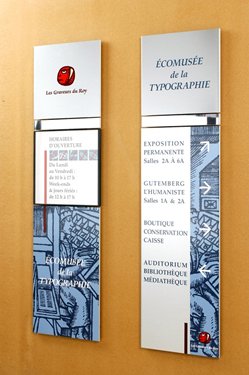Wayfinding can help people navigate through unfamiliar settings within buildings. By answering the question, “Which path should I take?” in any given direction, wayfinding provides the methods that people can take to reach their destination.
Right information in the right place
It’s important to understand that wayfinding solutions can solve problems by providing information at decision points. Many companies can make signs, but very few can help solve wayfinding and information management problems. Well-executed wayfinding involves providing the right information, in the right place and at the right time.
In buildings, people are on the move and need to make quick decisions about their surroundings. The wayfinding needs of visitors and guests visiting a building can vary greatly as you consider spatial awareness and people visiting unfamiliar settings.
 Well-defined journey through spaces
Well-defined journey through spaces
The power of wayfinding to connect buildings is providing a clear journey to travel and directions to help people know where to go as well as reassurance that it’s the right path. Wayfinding also provides identification to confirm a location, navigate through puzzling hallways or find the exit. The location of wayfinding signage in a building can be helpful at decision points such as entrances, elevators, hallways and exits.
Directional wayfinding and ADA compliance
Wayfinding solutions can help eliminate confusion, reduce stress and make a brand more visible. Well-placed wayfinding signage in hospitals and healthcare buildings can be helpful for visitors that are experiencing stress, fear, anxiety, joy and relief. In museums and public spaces, wayfinding helps visitors navigate from the parking signs to the monument signs at the main entrance of a building.
Wayfinding solutions are often needed to address regulatory compliance by identifying accessible environments for the disabled. Americans with Disabilities Act (ADA) compliant signs can point out building entrances and are useful for connecting rooms within buildings and other functional spaces.
Enhance the look of buildings
Whether the need is for simple directories or complex wayfinding systems, it’s possible to seamlessly integrate wayfinding with brand identity to connect buildings. SEGD’s article, What is Wayfinding? defines wayfinding as directional guidance through a carefully planned sequence. Digital wayfinding can also enhance the look of any space using kiosks, digital screens and digital directories.

Building directories can visually connect wayfinding by providing graphics, maps, lists of names, site diagrams and destinations at a specific building, facility or public venue. The look of a building or environment can be enhanced with directional signs, wall and door signs, name plates and parking lot signs, which can be branded to make a facility or building look better and become easier to navigate.
Learn more about harnessing the power of wayfinding to connect buildings. Tweet us @FASTSIGNS to share your wayfinding stories and photos.
TO READ MORE, VISIT FASTSIGNS.